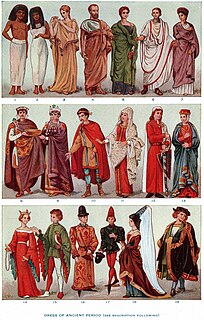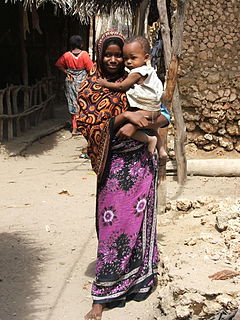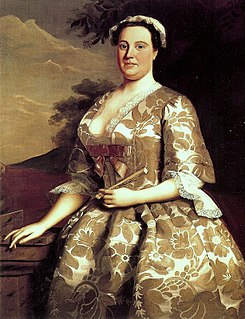
Clothing are items worn on the body. Typically, clothing is made of fabrics or textiles, but over time it has included garments made from animal skin and other thin sheets of materials and natural products found in the environment, put together. The wearing of clothing is mostly restricted to human beings and is a feature of all human societies. The amount and type of clothing worn depends on gender, body type, social factors, and geographic considerations.
Antony Price is an English fashion designer best known for evening wear and suits, and for being as much an "image-maker" as a designer. He has collaborated with a number of high-profile musicians, including David Bowie, Robert Palmer, Iva Davies, Steve Strange, and Duran Duran, but especially Bryan Ferry and Roxy Music, whose look was defined by Price's designs. The manner in which Price dressed – or in many cases, undressed – the "Roxy girls" on the covers of their albums helped to define the band's pop retro-futurism.

A shirt is a cloth garment for the upper body.
Stephen Sprouse was a fashion designer and artist credited with pioneering the 1980s mix of "uptown sophistication in clothing with a downtown punk and pop sensibility".

Jermyn Street is a one-way street in the St James's area of the City of Westminster in London, England. It is to the south of, parallel, and adjacent to Piccadilly. Jermyn Street is known as a street for gentlemen's-clothing retailers.

Thomas Pink Limited was a British shirt-maker. It was established in London in 1984 by three Irish brothers – James, Peter and John Mullen. From 1999 it was part of the Louis Vuitton Moët Hennessy group. In 2018 it lost £23.5 million. The company changed its name to Pink Shirtmaker in November 2018, and it was put up for sale in December 2020. It closed in January 2021.

African clothing is the traditional clothing worn by the peoples of Africa.

A dress shirt, button shirt, button-front, button-front shirt, or button-up shirt is a garment with a collar and a full-length opening at the front, which is fastened using buttons or shirt studs. A button-down or button-down shirt is a dress shirt which has a button-down collar – a collar having the ends fastened to the shirt with buttons.
Turnbull & Asser is a bespoke shirtmaker established in 1885. The company has its flagship store on Jermyn Street, St James's, as well as its bespoke store around the corner on Bury Street. In addition to the two London stores, it has a store located in New York.
John Stephen, dubbed by the media "The £1m Mod" and "The King Of Carnaby Street", was one of the most important fashion figures of the 1960s.

Edward Sexton is a British Savile Row tailor, fashion designer and manufacturing consultant. Sexton has been called a key player in the history of Savile Row.

Joseph Ephraim Casely-Hayford was a British fashion designer. Beginning in the mid-1980s he established an international reputation as one of the UK's most respected and consistently relevant designers of men's and womenswear clothing. He was appointed an Officer of the Order of the British Empire, for services to the fashion industry, in the 2007 Birthday Honours.

Anna Maria Garthwaite was an English textile designer known for creating vivid floral designs for silk fabrics hand-woven in Spitalfields, London, in the mid-18th century. Garthwaite was acknowledged as one of the premiere English designers of her day. Many of her original designs in watercolours have survived, and silks based on these designs have been identified in portraiture and in costume collections in England and abroad.
Oscar Udeshi is a luxury menswear designer of Austrian and Zanzibar heritage.

Timothy Charles Peto Everest is a Welsh tailor and fashion designer. He moved to London in his early twenties to work with the Savile Row tailor Tommy Nutter. He then became one of the leaders of the New Bespoke Movement, which brought designer attitudes to the traditional skills of Savile Row tailoring.

Savile Row tailoring is men and women's bespoke tailoring that takes place on Savile Row and neighbouring streets in Mayfair, Central London. In 1846, Henry Poole, credited as being the "Founder of Savile Row", opened an entrance to his tailoring premises into No. 32 Savile Row. The term "bespoke" is understood to have originated in Savile Row when cloth for a suit was said to "be spoken for" by individual customers. The short street has been termed the "golden mile of tailoring", where customers have included Charles, Prince of Wales, Jude Law, Winston Churchill, Muhammad Ali Jinnah, Laurence Olivier, Duke Ellington, Lord Nelson and Napoleon III.
Alan Holston was a British fashion entrepreneur, one of the co-founders of Dandie Fashions, a Chelsea boutique that was a key part of Swinging London.

Tom Gilbey was a British fashion designer associated with Savile Row tailoring of the 1960s. His designs have featured in the Fashion Museum, Bath, and are in the collections of the Victoria & Albert Museum and the Museum of London.
Gerald McCann was a British fashion designer who was considered among the leading lights of the Swinging London fashion scene, alongside names such as Mary Quant, subsequently moving to the United States to continue his career with Larry Levine.

Budd is a high-end tailor for shirts based in London's Piccadilly Arcade. Budd was founded in 1910, and is known to cater to many notable figures of British high society.












